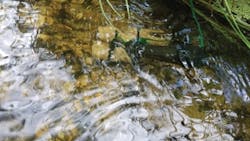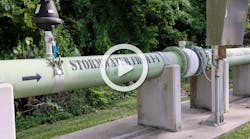Tricky Transaction
In recent years, the Wisconsin Department of Natural Resources (WDNR) has established stringent phosphorus limits for Wisconsin’s waterways. The new regulations state that direct discharges to Wisconsin’s rivers and streams must have phosphorus concentrations of less than 0.075 mg/L, with direct discharges to lakes requiring concentrations as low as 0.03 mg/L.
The new phosphorus limitations can be challenging and expensive for wastewater treatment facilities to meet, requiring flexible and creative engineering solutions. Allowing point source dischargers to trade phosphorus credits with other point or non-point sources can be part of the solution for many dischargers.
Phosphorus is a naturally occurring nutrient present in raw materials such as milk. It generally is found as phosphate, and is used widely in fertilizer, detergent and animal feed. It also is recognized as the controlling factor for plant and algae growth in Wisconsin’s lakes and streams. Excessive amounts of phosphorus released into local ecosystems are contributors to the eutrophication (nutrient enrichment) of Wisconsin’s waterways, which can have detrimental effects on aquatic wildlife.
One-fourth of the more than 700 water bodies on Wisconsin’s impaired waterways list fail to meet water quality standards due to phosphorus pollution. Statewide, dozens of waterways experience harmful algae blooms fueled by the nutrient, posing a health threat to people, pets and livestock. Over the past three years, 98 people have reported health claims related to such blooms. Recent statewide stream assessment data suggest thousands of streams may have excess phosphorus.
Phosphorus Limits
Effluent discharged from wastewater treatment plants (WWTPs) has been identified as a contributor to elevated levels of phosphorus entering local lakes and streams. As a result, WDNR has implemented one of the most stringent phosphorus discharge standards in the nation. In December 2010, the department revised NR 102 and NR 217 of the Wisconsin Administrative Code, establishing strict phosphorus limitations for Wisconsin’s lakes, reservoirs, rivers and streams. Unless specifically exempt in NR 102, direct discharges to Wisconsin’s waterways have phosphorus limits ranging down to 0.03 mg/L.
Facilities throughout the state are required to optimize their WWTPs in order to meet the limitations set forth by WDNR. Compliance options include facility updates that add treatment technologies, water quality trading, adaptive management and limited variance options.
Water Quality Trading
Water quality trading is one of several tools available to Wisconsin Pollutant Discharge Elimination System permit holders to help them comply with the new, more restrictive water quality-based effluent limitations.
Water quality trading allows point sources to offset their pollution load and comply with phosphorus limits by taking credit for other phosphorus reductions in the watershed. It can be a cost-effective option for dischargers to ensure compliance with restrictive phosphorus limits while improving overall water quality. Trade credits can be used to counter process upsets, provide an alternative to the installation of redundant tertiary treatment systems and allow for a small margin of relief at the point source while reducing the non-point source impact on the watershed.
Water quality trading involves identifying, quantifying and implementing sources of trade. Trading can occur between point sources, but is more likely between a non-point and point source. There are several methods for non-point sources (i.e., agricultural facilities) to reduce their phosphorus discharge and qualify for a trade. The most likely methods include whole-field management, companion cropping, conservation easement and nutrient management.
To quantify a trade from a non-point discharge, modeling with SNAP-Plus or an equivalent nutrient management planning software is required. Once the modeling determines the amount of phosphorus that can be offset with the management practice, a trade ratio is applied. There are five factors that go into a trade ratio: delivery, downstream, equivalency, uncertainty and habitat adjustment.
Water quality trading is different from adaptive management—another method of offsetting point source phosphorus—in that trading focuses on compliance with an individual discharger’s permitted limits. Adaptive management is based on all sources contributing to the watershed collectively meeting in-stream criteria. Because of this, trading is a more reliable management alternative, as it eliminates the influence of uninvolved parties. Adaptive management is monitored by the quality of a water body, which may be affected by other sources outside of the point source discharger’s control.
WDNR recommends that dischargers review their compliance options well in advance of the time their permit renewal is due in order to have sufficient time to make informed compliance decisions, as developing and implementing a successful trading strategy can take three to five years.
Wisconsin's First Trade
With phosphorus and water quality in Wisconsin’s lakes and streams at the forefront of local environmental concerns, WDNR recently approved its first water quality trade agreement for Baker Cheese, located in St. Cloud, Wis.
Baker Cheese historically had collected process wastewater at its facility and hauled it to local municipalities for treatment and ultimate discharge at a fairly significant and increasing annual cost. In order for the cheese manufacturer to economically expand its production facility, Baker decided to treat its process wastewater on site by constructing a new WWTP. The permitted discharge from the treatment plant was subject to the stringent 0.075 mg/L phosphorus limit that was established in 2010.
Fortunately for Baker Cheese, it was able to purchase 20 acres of farmland in the same sub-watershed as its new discharge—a great opportunity for a trade. For the prior three years, these fields had been subject to crop rotation, including soybeans and corn silage. Soil sampling and modeling was able to show the potential for tradeable phosphorus based on the crop or vegetative cover that would occupy these fields.
After extensive coordination, research and modeling, a successful trade strategy that allows the facility to meet phosphorus discharge limits and also reduces the overall amount of phosphorus released to the local watershed was approved by WDNR. In order to provide the maximum benefit to the local watershed, permanent vegetative cover will occupy all three fields.
“Not only are we meeting all of the water quality requirements expected of us, but we’ve added some meaningful habitat to the local land base and are growing our business at the same time,” said Jeff Baker, vice president of Baker Cheese.
For Baker Cheese, the approved trade means increased production capabilities at a reduced cost and the potential for business expansion, all while ensuring benefit to the local environment.


